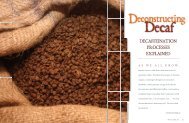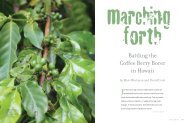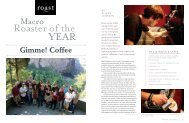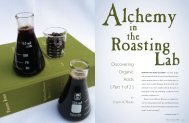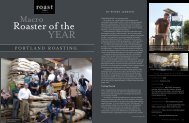to download a low resolution preview of this article - Roast Magazine
to download a low resolution preview of this article - Roast Magazine
to download a low resolution preview of this article - Roast Magazine
Create successful ePaper yourself
Turn your PDF publications into a flip-book with our unique Google optimized e-Paper software.
the<br />
ART<br />
<strong>of</strong> the<br />
BLEND<br />
Channeling inspiration<br />
in<strong>to</strong> the cup<br />
by<br />
kathi<br />
zollman<br />
Some c<strong>of</strong>fee blends greet us in the morning …<br />
Sunrise Blend<br />
Or cleverly tell us where the c<strong>of</strong>fee is from …<br />
Two Continent Blend<br />
While others can create a state <strong>of</strong> mind …<br />
Blue Jazz Java House Band<br />
There are regional c<strong>of</strong>fee blends that,<br />
with their names alone, can take us home …<br />
Back Porch Blend<br />
And some reach out <strong>to</strong> remind us <strong>of</strong> our roots …<br />
Creole C<strong>of</strong>fee & Chicory<br />
Still other blend names act as a<br />
souvenir <strong>of</strong> last summer’s vacation …<br />
Glacier Centennial<br />
continued on page 22<br />
March | April 2011 21
The Art <strong>of</strong> the Blend: Channeling Inspiration in<strong>to</strong> the Cup (continued)<br />
C<strong>of</strong>fee drinkers wake up each morning <strong>to</strong> a fresh-brewed<br />
breakfast blend <strong>of</strong> choice. The smell is sweet and<br />
familiar and, most importantly at <strong>this</strong> early hour, the<br />
breakfast blend tastes perfect. Morning is not right without<br />
it. The fact that a skilled roaster <strong>to</strong>iled over the blend <strong>to</strong> create<br />
a perfect wake-me-up cup is usually overlooked. For those<br />
faithful c<strong>of</strong>fee drinkers, there is no replacement for a favorite<br />
morning blend.<br />
Blending is respected as an art form among c<strong>of</strong>fee<br />
pr<strong>of</strong>essionals. The process not only requires skills in cupping<br />
and flavor analysis, but also an understanding <strong>of</strong> the roasting<br />
process.<br />
Although blended c<strong>of</strong>fees make up a large portion <strong>of</strong> the<br />
specialty industry, many roasters build businesses by initially<br />
<strong>of</strong>fering fresh-roasted single-origin c<strong>of</strong>fees, bringing new<br />
origins and exotic c<strong>of</strong>fees <strong>to</strong> the fledgling c<strong>of</strong>fee consumer.<br />
But as these same c<strong>of</strong>fee markets mature, blends have<br />
become a mainstay for building cus<strong>to</strong>mer loyalty. Branding<br />
through blends is a consistently winning formula for c<strong>of</strong>fee<br />
roasting companies <strong>of</strong> all sizes. C<strong>of</strong>fee blends <strong>of</strong>ten reflect<br />
regional variations—think about the dark blends <strong>of</strong> the West<br />
Coast, mild Midwestern blends, blends for iced c<strong>of</strong>fees in the<br />
warm Southeast, and c<strong>of</strong>fee and chicory <strong>of</strong> the Mississippi<br />
Delta. Blends such as these play an extremely important role<br />
in the successes <strong>of</strong> <strong>to</strong>day’s roasters.<br />
DEFINING A BLEND<br />
skillfully bringing <strong>to</strong>gether c<strong>of</strong>fees from different growing regions.<br />
These c<strong>of</strong>fees come from either a single origin or multiple origins.<br />
In the world <strong>of</strong> specialty c<strong>of</strong>fee, the definition <strong>of</strong> a blend varies<br />
for each roaster, but most agree that blending brings limitless<br />
possibilities <strong>to</strong> the roastery. Blending inspires roasters <strong>to</strong><br />
explore new or unique flavor pr<strong>of</strong>iles that can be achieved<br />
only when two or more c<strong>of</strong>fees are brought <strong>to</strong>gether. When<br />
done well, blends provide consistency with reliable flavor and<br />
quality in the cup. They are <strong>of</strong>ten more complex, creating<br />
A single c<strong>of</strong>fee roasted <strong>to</strong> various pr<strong>of</strong>iles also fits the definition <strong>of</strong><br />
blend. Great c<strong>of</strong>fees are combined <strong>to</strong> create a flavor experience that<br />
is better than the independent parts. A well-constructed blend is<br />
created so adeptly that the individual components are not easily<br />
identified, but rather the cup is evaluated and enjoyed as a whole.<br />
Several other variations on <strong>this</strong> theme come in<strong>to</strong> play when<br />
defining a blend:<br />
more dimension and appeal than a single-origin c<strong>of</strong>fee.<br />
<strong>Roast</strong>ers advise that quality green c<strong>of</strong>fee and solid roasting<br />
practices are requisites for high-quality results. When a<br />
1<br />
Green c<strong>of</strong>fees mixed <strong>to</strong>gether at origin <strong>to</strong> fulfill a specific<br />
c<strong>of</strong>fee flavor pr<strong>of</strong>ile are considered a blend. This green<br />
roaster creates a proprietary “house blend,” it should represent<br />
an implied assurance <strong>of</strong> quality in the cup, not an assumption<br />
<strong>of</strong> <strong>low</strong>-quality blender c<strong>of</strong>fee. Blends are an opportunity <strong>to</strong><br />
showcase outstanding flavors and roasting skill by bringing<br />
c<strong>of</strong>fees <strong>to</strong>gether for a distinct c<strong>of</strong>fee experience. In addition,<br />
single-origin blend—mostly from a single farm—is <strong>of</strong>ten referred <strong>to</strong><br />
as a homogenous blend. Homogenous blends also result when<br />
working with small-scale farm co-ops, where green c<strong>of</strong>fees from<br />
multiple farms within a geographic area are brought <strong>to</strong>gether as<br />
one. Another consideration: the homogenous blends created in<br />
large volume for commercial roasters.<br />
they create a sense <strong>of</strong> balance that may not be possible in a<br />
Crafting a blend made up <strong>of</strong> roasted components is a widely<br />
3<br />
single-origin c<strong>of</strong>fee, and blending can smooth an extreme<br />
used technique called post-roast blending. Purists will argue<br />
Green c<strong>of</strong>fees proportionately mixed <strong>to</strong>gether prior <strong>to</strong><br />
characteristic or add dimension <strong>to</strong> round out a cup. From a<br />
2<br />
that <strong>this</strong> is the superior methodology for creating great blends, as<br />
roasting are considered a pre-roast blend. This is a common<br />
business standpoint, blending can be used <strong>to</strong> achieve specific<br />
each component is roasted perfectly and then mixed <strong>to</strong>gether. As<br />
practice for roasters producing large quantities <strong>of</strong> a specific blend;<br />
price points and maintain a desired level <strong>of</strong> pr<strong>of</strong>itability.<br />
with most <strong>to</strong>pics in specialty c<strong>of</strong>fee, there is no right or wrong<br />
the roasters using <strong>this</strong> method appreciate the efficiency <strong>of</strong> the<br />
The definition <strong>of</strong> a blend may be broad or inclusive—even<br />
answer, leaving plenty <strong>of</strong> room for lively debate.<br />
technique.<br />
brewed c<strong>of</strong>fees mixed <strong>to</strong>gether on the cupping table can be<br />
called a blend. However, simply defined, blending means continued on page 24<br />
22 roast March | April 2011 23
The Art <strong>of</strong> the Blend: Channeling Inspiration in<strong>to</strong> the Cup (continued)<br />
WHO BLENDS?<br />
In an informal and unscientific survey<br />
<strong>of</strong> roasters around the United States, 94<br />
percent <strong>of</strong> respondents affirmed that<br />
blends share space on their c<strong>of</strong>fee menus.<br />
Micro-roasters and midsize regional<br />
roasters consider blends an integral<br />
part <strong>of</strong> their success. Many stated that<br />
blends have been a part <strong>of</strong> their c<strong>of</strong>fee<br />
roasting business from the start, building<br />
cus<strong>to</strong>mer loyalty with targeted brand<br />
awareness. One <strong>of</strong> these companies<br />
has celebrated 30 years in the roasting<br />
business and applauds its blend programs<br />
as an invaluable part <strong>of</strong> the company’s<br />
success s<strong>to</strong>ry.<br />
The importance <strong>of</strong> including blend<br />
<strong>of</strong>ferings also holds true with roasters<br />
who feature high-end single-origin and<br />
exclusive direct-trade c<strong>of</strong>fees. It appears<br />
that these roasters have found a balance<br />
in their roasting business <strong>to</strong> feature the<br />
WHY BLEND?<br />
exquisite single-origin c<strong>of</strong>fees alongside<br />
proprietary blends, finding a market<br />
and success in both revenue streams. For<br />
other roasters, blends become part <strong>of</strong> the<br />
product mix as their businesses grow,<br />
especially when creating new wholesale<br />
markets. Overall, these roasters attribute<br />
10 percent <strong>to</strong> as much as 100 percent<br />
<strong>of</strong> their annual sales volume <strong>to</strong> sales <strong>of</strong><br />
blended c<strong>of</strong>fees. These findings support<br />
the idea that blends are an integral part <strong>of</strong><br />
a diversified c<strong>of</strong>fee menu, resulting in a<br />
wider appeal <strong>to</strong> a varied cus<strong>to</strong>mer base.<br />
The geographic location <strong>of</strong> these c<strong>of</strong>fee<br />
companies seems <strong>to</strong> have little effect<br />
on the importance <strong>of</strong> blends for these<br />
roasters. Although blend names and styles<br />
vary from East <strong>to</strong> West, overall the blends<br />
are important <strong>to</strong> the cus<strong>to</strong>mers wherever<br />
they drink their c<strong>of</strong>fee.<br />
Though roasters have different reasons for <strong>of</strong>fering blended c<strong>of</strong>fees, most rationales can<br />
be boiled down in<strong>to</strong> three distinct categories:<br />
1<br />
Use blends as a marketing <strong>to</strong>ol <strong>to</strong> distinguish your<br />
business from the competition.<br />
A well-prepared blend will separate a roaster from the competition, making these<br />
secret-recipe mixes a useful marketing <strong>to</strong>ol for roasters <strong>of</strong> any size. <strong>Roast</strong>ers have the<br />
opportunity <strong>to</strong> be the sole outlet for a specific blend or make it available through larger<br />
continued on page 26<br />
BLEND<br />
sTYLES<br />
Bringing c<strong>of</strong>fees <strong>to</strong>gether successfully comes with practice<br />
and experience. Outstanding blends are the result <strong>of</strong> careful planning<br />
and skillfully executing that plan from start <strong>to</strong> finish. And, as admitted<br />
by several roasters, skill is <strong>of</strong>ten combined with pure luck. The details <strong>of</strong><br />
these great blends are considered trade secrets and are carefully guarded;<br />
don’t expect a roaster <strong>to</strong> reveal the specifics <strong>of</strong> a blend. Many roasters<br />
learned their skills from a roastmaster who <strong>of</strong>fered hands-on training in<br />
the art <strong>of</strong> blending. Those roasters then <strong>to</strong>ok the art and made it their<br />
own. While the precise details aren’t shared, here are some generalities<br />
worth noting:<br />
Harmonious blends<br />
Harmonious blends result<br />
from selecting c<strong>of</strong>fees that<br />
have common types <strong>of</strong> flavor.<br />
Think <strong>of</strong> vanilla ice cream and<br />
caramel sauce, similar flavors<br />
that combine harmoniously<br />
<strong>to</strong> create a luscious flavor.<br />
<strong>Roast</strong>ers can look for c<strong>of</strong>fees<br />
that have similar flavor <strong>to</strong> create<br />
a wonderful signature blend.<br />
Keep in mind the proportion<br />
<strong>of</strong> each component. After<br />
all, a bowl full <strong>of</strong> vanilla ice<br />
cream with just a dribble <strong>of</strong><br />
caramel sauce is a different<br />
experience than a bowl full <strong>of</strong><br />
caramel sauce with a dollop<br />
<strong>of</strong> ice cream. <strong>Roast</strong>ers must<br />
successfully find the balance<br />
<strong>of</strong> the parts <strong>to</strong> produce the<br />
best flavor in the cup. Look for<br />
c<strong>of</strong>fees with similar primary<br />
flavors. To achieve harmony,<br />
experiment with origins like<br />
Peru and Colombia at different<br />
degrees <strong>of</strong> roast. Or, consider<br />
c<strong>of</strong>fees with similar attributes—<br />
body, for example. A heavybodied<br />
natural Brazil with<br />
a rich Sumatra can produce<br />
harmonious results. Look at the<br />
limitless possibilities <strong>to</strong> create<br />
overall harmony and balance in<br />
the cup.<br />
Tension-creating blends<br />
Tension-creating blends result when<br />
dissimilar components are mixed<br />
<strong>to</strong>gether. Think opposing flavors<br />
on the palate: sweet and sour, tart<br />
and buttery. Visualize a tall glass<br />
<strong>of</strong> lemonade, sour and refreshing.<br />
Take that same glass and add a<br />
few sweet strawberries <strong>to</strong> the<br />
lemonade; the bright citrus edge<br />
becomes s<strong>of</strong>ter with the addition<br />
<strong>of</strong> the extra sweetness, resulting<br />
in a more winey flavor than the<br />
original brew. The same is true when<br />
a fresh lemon is squeezed over a<br />
bowl <strong>of</strong> strawberries. The berries<br />
become even sweeter with a pop <strong>of</strong><br />
tartness, resulting in another layer <strong>of</strong><br />
dimension <strong>to</strong> the overall flavor.<br />
To build tension-creating blends,<br />
look for contrast—for example, a<br />
super-clean Yirgacheffe is turned<br />
winey with a hint <strong>of</strong> blueberry<br />
Harrar. Consider uncommon flavor<br />
combinations for the ultimate<br />
tension-creating blends. These types<br />
<strong>of</strong> blends require more patience<br />
and an intuitive skill about flavor.<br />
Experiment with high-acid c<strong>of</strong>fees<br />
paired with those that have a heavy,<br />
dense body. What happens when you<br />
add a bit <strong>of</strong> a bright Costa Rica <strong>to</strong> a<br />
rich Java? It’s especially important <strong>to</strong><br />
avoid common pairings. Once <strong>this</strong><br />
blending skill is mastered, roasters<br />
will discover that the tension is<br />
actually a form <strong>of</strong> balance.<br />
24 roast March | April 2011 25
The Art <strong>of</strong> the Blend: Channeling Inspiration in<strong>to</strong> the Cup (continued)<br />
distribution streams; either way, the result<br />
can be pr<strong>of</strong>itable. “The proprietary nature<br />
<strong>of</strong> blends al<strong>low</strong>s you <strong>to</strong> keep cus<strong>to</strong>mers<br />
coming back because they can only get them<br />
from you,” says Kevin Conard, the owner <strong>of</strong><br />
Cardona C<strong>of</strong>fee Brands <strong>of</strong> Topeka, Kan.<br />
Other roasters find success in creating<br />
cus<strong>to</strong>m blends, complete with a unique flavor<br />
and name, designed for a specific wholesale<br />
cus<strong>to</strong>mer. Or by creating a private-label<br />
program. Blends are an opportunity for<br />
roasters <strong>to</strong> develop their own brands that<br />
ultimately build cus<strong>to</strong>mer loyalty. Branded<br />
c<strong>of</strong>fees also contribute <strong>to</strong> an element <strong>of</strong><br />
mystique by presenting a great c<strong>of</strong>fee<br />
product with a unique name—all created for<br />
a specific c<strong>of</strong>fee consumer. In some cases,<br />
the name <strong>of</strong> the blend is so well received<br />
that the c<strong>of</strong>fee sells by the name alone,<br />
without consideration <strong>of</strong> what the blend is<br />
made <strong>of</strong>. These names might include<br />
the roaster’s name (such as Bob’s Best<br />
Blend from C<strong>of</strong>fee <strong>Roast</strong>ers <strong>of</strong> New<br />
Orleans) or a regional landmark (Glacier<br />
Centennial by Montana C<strong>of</strong>fee Traders),<br />
creating a perception <strong>of</strong> quality and<br />
familiarity by branding alone.<br />
2<br />
Craft a c<strong>of</strong>fee that’s<br />
better than each<br />
individual component.<br />
Another important reason <strong>to</strong> blend<br />
c<strong>of</strong>fees is <strong>to</strong> create a style or flavor<br />
that comes about only when uniting<br />
two or more c<strong>of</strong>fees. It is human<br />
nature <strong>to</strong> combine different elements<br />
just <strong>to</strong> reveal the result. “Taking real<br />
specialty c<strong>of</strong>fees and blending can<br />
create some great stuff,” says Jeremy<br />
Raths, roastmaster at The <strong>Roast</strong>ery in<br />
Minneapolis. “And the process is fun,”<br />
he adds.<br />
With their blending experiments,<br />
roasters aim <strong>to</strong> create a consistent,<br />
balanced cup with roundness, depth<br />
and complexity. <strong>Roast</strong>ers rely on <strong>this</strong><br />
consistency <strong>to</strong> build loyalty and repeat<br />
sales. It’s important that specialty<br />
c<strong>of</strong>fee cus<strong>to</strong>mers are rewarded with<br />
the same flavor every time they make<br />
a repeat purchase <strong>of</strong> a blend, so there<br />
is no mystery as <strong>to</strong> what the c<strong>of</strong>fee will<br />
taste like.<br />
A c<strong>of</strong>fee with extreme sweetness<br />
but little brightness can be sparked<br />
by blending with a more acidy c<strong>of</strong>fee.<br />
A thin but tasty c<strong>of</strong>fee can be given<br />
more dimension by mixing it with<br />
a more rounded c<strong>of</strong>fee. Think <strong>of</strong><br />
creating a complete flavor dynamic that<br />
rewards the senses—taste, aroma and<br />
mouthfeel. Milk chocolate is wonderful<br />
by itself, and many enjoy peanut<br />
butter, but when combined, the taste<br />
treat becomes something very different<br />
from the components. The same process<br />
can be used in designing a blend. And<br />
discovery at the cupping table, tasting<br />
new and different flavor creations, is a<br />
great joy.<br />
Not every blend design is a success<br />
s<strong>to</strong>ry; there are pitfalls as the student<br />
becomes a master, learning both the art<br />
and science <strong>of</strong> creating a blend. Practice<br />
and a carefully constructed plan help<br />
determine which c<strong>of</strong>fees are selected for<br />
specific attributes. But even then, there<br />
are times when great-tasting c<strong>of</strong>fees<br />
don’t blend well and the results are a<br />
disappointment at the cupping table.<br />
3<br />
Protect the company’s<br />
bot<strong>to</strong>m line.<br />
“Ultimately, there has <strong>to</strong> be a business<br />
purpose for blending,” says Joe M<strong>of</strong>fatt,<br />
the roaster and owner <strong>of</strong> Tupelo, Miss.-<br />
based Joe Joe’s C<strong>of</strong>fee & Tea. Pricing<br />
is increasingly important <strong>to</strong> those<br />
who rely on blends as a part <strong>of</strong> their<br />
pr<strong>of</strong>itability picture. <strong>Roast</strong>ers are able <strong>to</strong><br />
take advantage <strong>of</strong> less expensive, quality<br />
c<strong>of</strong>fees <strong>to</strong> attain a higher margin.<br />
<strong>Roast</strong>ers use blends <strong>to</strong> expand their<br />
<strong>of</strong>ferings, which may result in increased<br />
sales and pr<strong>of</strong>its through a larger reach.<br />
Quality blends al<strong>low</strong> roasters <strong>to</strong> enter<br />
new markets that might not have<br />
been otherwise available, ultimately<br />
increasing the overall sales volume <strong>of</strong> the<br />
business. In other markets, blends have<br />
been added <strong>to</strong> meet a competitive need or<br />
price point, and roasting businesses may<br />
be enjoying increased bean sales and<br />
pr<strong>of</strong>its as a result <strong>of</strong> an expanded blend<br />
portfolio.<br />
Other roasters suggest that blends<br />
have al<strong>low</strong>ed them <strong>to</strong> expand their<br />
cus<strong>to</strong>mer base by providing more<br />
varieties and styles <strong>of</strong> c<strong>of</strong>fee that appeal<br />
<strong>to</strong> more people, resulting directly in<br />
additional income. Blends also al<strong>low</strong><br />
roasters <strong>to</strong> maintain price stability for<br />
cus<strong>to</strong>mers by selecting c<strong>of</strong>fees within a<br />
range <strong>of</strong> price acceptability. For many<br />
roasters, blends are a pr<strong>of</strong>it center and<br />
contribute <strong>to</strong> the financial success <strong>of</strong> the<br />
roastery.<br />
HOW DO<br />
YOU BLEND?<br />
Before starting the blending process,<br />
take a few minutes <strong>to</strong> review the c<strong>of</strong>fees<br />
on hand. Knowing and understanding<br />
the available c<strong>of</strong>fees is imperative.<br />
Mistakes and experiments can be<br />
expensive, and being well prepared<br />
helps control some <strong>of</strong> the new product<br />
development costs incurred when<br />
designing a blend.<br />
Learn about each <strong>of</strong> the c<strong>of</strong>fees. How<br />
do they perform at different roast levels?<br />
Which c<strong>of</strong>fees are sweet and which are<br />
bright? Which c<strong>of</strong>fees in the inven<strong>to</strong>ry<br />
have body? <strong>Roast</strong>ers may want <strong>to</strong> create a<br />
catalog <strong>of</strong> c<strong>of</strong>fees noting the outstanding<br />
cup characteristics <strong>of</strong> each c<strong>of</strong>fee. This<br />
information serves as a valuable reference<br />
<strong>to</strong>ol when designing a blend.<br />
Every roaster has a unique methodology<br />
when it comes <strong>to</strong> creating a blend. The roaster<br />
uses the specific purpose <strong>of</strong> the new blend as<br />
the road map. And, although roasters do not<br />
openly share their exact processes, there are a<br />
few generalizations we can take away: First,<br />
identify the purpose <strong>of</strong> the blend. Next, plan<br />
and build the blend. And lastly, evaluate the<br />
results.<br />
continued on page 28<br />
26 roast March | April 2011 27
The Art <strong>of</strong> the Blend (continued)<br />
1<br />
Identify the purpose<br />
<strong>of</strong> the new blend.<br />
What is the aim <strong>of</strong> <strong>this</strong> blend—is it a new cus<strong>to</strong>mer-specific<br />
blend? Should it pair well with desserts, create a new flavor<br />
for a new-arrival c<strong>of</strong>fee, or help with cost control? The list <strong>of</strong><br />
possibilities is lengthy, but results are more easily evaluated<br />
if the overall objective <strong>of</strong> the blend is identified before the<br />
roaster invests time and product in the process. Be prepared <strong>to</strong><br />
name the new blend. The name is as important as the other<br />
components and will directly drive the success <strong>of</strong> the blend.<br />
2<br />
Develop a plan<br />
<strong>of</strong> action.<br />
Review the c<strong>of</strong>fees available for the blend and consider the<br />
degree <strong>of</strong> roast for each. Will the c<strong>of</strong>fees be blended prior<br />
<strong>to</strong> roasting or afterward? Although most roasters prefer <strong>to</strong><br />
blend post-roast, there are others who argue that blending<br />
green c<strong>of</strong>fee prior <strong>to</strong> roasting contributes <strong>to</strong> efficiency when<br />
working with voluminous amounts <strong>of</strong> c<strong>of</strong>fee. Even some <strong>of</strong><br />
the staunchest supporters <strong>of</strong> the post-roast blend philosophy<br />
acknowledge that excellent-tasting results can also be<br />
achieved with pre-blending, and some<br />
roasters use a combination <strong>of</strong> the two<br />
methods successfully. <strong>Roast</strong>ers should<br />
also consider continuity <strong>of</strong> the blend<br />
when creating the action plan. Are the<br />
c<strong>of</strong>fees selected readily available? Is<br />
the price consistent? Are there c<strong>of</strong>fees<br />
that can be substituted if necessary?<br />
All are important considerations when<br />
penciling out a new blend.<br />
3<br />
Build the<br />
blend.<br />
Once all <strong>of</strong> the research has been<br />
completed and the components are in<br />
place, it’s time <strong>to</strong> create the blend. For<br />
research purposes, take notes on each<br />
step <strong>of</strong> the process, including pr<strong>of</strong>ile<br />
notes and the ratios <strong>of</strong> the c<strong>of</strong>fees. It<br />
is frustrating <strong>to</strong> create an outstanding<br />
blend and be unable <strong>to</strong> duplicate the<br />
results because it was created free form.<br />
Don’t leave success <strong>to</strong> chance; track the<br />
blend development from start <strong>to</strong> finish.<br />
It is also imperative that the blend meets<br />
cost goals; it’s upsetting <strong>to</strong> build a<br />
dynamic blend only <strong>to</strong> discover that it is<br />
<strong>to</strong>o costly <strong>to</strong> produce effectively.<br />
continued on page 30<br />
28 roast March | April 2011 29
The Art <strong>of</strong> the Blend (continued)<br />
4 Evaluate<br />
the cup.<br />
Comment on the cup attributes <strong>of</strong> the<br />
blend; look for a balanced cup and overall<br />
pleasantness. Compare the results <strong>to</strong><br />
the original goals <strong>of</strong> the blend. Does the<br />
blend meet the criteria set forth? List the<br />
positive attributes as well as any negative<br />
evaluations that need <strong>to</strong> be corrected. Note<br />
the changes that need <strong>to</strong> be made and<br />
repeat the process <strong>to</strong> fine-tune the blend.<br />
As an art form, well-designed c<strong>of</strong>fee<br />
blends enjoy success as a creative outlet<br />
and a business <strong>to</strong>ol for the roaster. In<br />
the c<strong>of</strong>fee world, a blend is a staple <strong>to</strong><br />
c<strong>of</strong>fee cus<strong>to</strong>mers. The skill and dedication<br />
<strong>to</strong> creating the perfectly balanced cup<br />
might be overlooked but not ignored by<br />
cus<strong>to</strong>mers. Blends are appreciated in the<br />
form <strong>of</strong> cus<strong>to</strong>mer loyalty, a common thread<br />
among the dozens <strong>of</strong> roasters willing <strong>to</strong><br />
discuss their blend philosophy.<br />
Cus<strong>to</strong>mers rely on the consistency<br />
and quality <strong>of</strong> an outstanding blend, and<br />
roasters are rewarded for their efforts with<br />
an extended cus<strong>to</strong>mer base and increased<br />
sales. There is room for both blends and<br />
single-origin c<strong>of</strong>fees in <strong>to</strong>day’s specialty<br />
market. And, like all skilled artists,<br />
roasters keep their blend secrets carefully<br />
under wraps.<br />
BLEND<br />
IDEAS<br />
Creating a blend can be both timeconsuming<br />
and expensive for beginners.<br />
To help roasters move in<strong>to</strong> the blending<br />
fast lane, here are some ideas for a classic<br />
drip blend and an espresso blend. Both are<br />
actual blends designed and implemented<br />
successfully. Beginners can use these as<br />
suggested or draw on them as a starting<br />
point <strong>to</strong> make the blend their own. <strong>Roast</strong> all<br />
components separately; blend thoroughly.<br />
Dessert Blend<br />
Complementary <strong>to</strong> desserts and pastries, <strong>this</strong> is an elegant c<strong>of</strong>fee by<br />
itself or when paired with baked goods.<br />
Combine:<br />
Kathi Zollman, assistant direc<strong>to</strong>r <strong>of</strong><br />
specialty green c<strong>of</strong>fee sales at C<strong>of</strong>fee Holding<br />
Company, is a frequent presenter at a variety <strong>of</strong><br />
roaster education venues. She has shared c<strong>of</strong>fee<br />
roasting skills at <strong>Roast</strong>ers Guild events, the annual<br />
SCAA Conference, C<strong>of</strong>fee Fest and multiple regional<br />
roaster gatherings. Providing quality training and<br />
skill building at a local level has been a focus for<br />
several years as Zollman has been involved in the<br />
grassroots regional movement. Specializing in<br />
blending, sensory skill building, pr<strong>of</strong>ile roasting and<br />
pr<strong>of</strong>ile manipulation, she continues <strong>to</strong> be a student <strong>of</strong><br />
all things c<strong>of</strong>fee. Reach her via e-mail at<br />
kzollman@c<strong>of</strong>feeholding.com.<br />
50 percent medium-dark-roast Guatemala Antigua<br />
25 percent medium-roast Costa Rica Tarrazu<br />
25 percent dark-roast Colombia Supremo or Excelso<br />
Kathi Z. Signature Espresso<br />
This espresso is best when poured as a double ristret<strong>to</strong>.<br />
Combine:<br />
40 percent medium-dark (<strong>to</strong> second crack) Sumatra<br />
20 percent dark-roast natural Brazil<br />
25 percent full-city-roast Guatemala Antigua<br />
15 percent dark-roast Colombia<br />
30 roast March | April 2011 31





